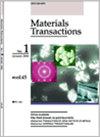Improving Bendability of 6000-Series Extruded Aluminum Profiles Using Dies through Shear Stress and Flow-Velocity Reduction
IF 1.9
4区 材料科学
Q4 MATERIALS SCIENCE, MULTIDISCIPLINARY
引用次数: 0
Abstract
Extruded profiles of Al–Mg–Si alloys are typically used in automotive applications. In this study, the microstructure of 6000-series alloys was improved in terms of the energy absorption property (bendability) using the shear stress and flow velocity generated during extrusion instead of conventional transition-metal alloying, because the latter presents challenges in reuse and recycling. This was accomplished using dies with different numbers of feeder holes. Furthermore, in a novel step, complementary finite element analysis (FEA) was conducted to investigate the effects of this improvement on microstructure strengthening. FEA results indicated that the profile obtained using the 4-hole die had lower internal shear stress distribution and aluminum flow velocity than using the 5-hole die. Cross-sectional electron backscatter diffraction observations revealed that the microstructure of the profile obtained using the 4-hole die had fine crystal grains and a strong internal cube or Goss preferential orientation, whereas that obtained using the 5-hole die exhibited coarse grains and an increased number of intermediate orientations. Consequently, the profile obtained using the 4-hole die exhibited improved bendability; furthermore, this die maintained the same tensile strength as the other specimen. Reducing the processing shear stress and flow velocity during extrusion allowed grain refinement and improved bendability at the same tensile strength.通过降低剪切应力和流速提高6000系列铝型材模具的可弯曲性
铝镁硅合金的挤压型材通常用于汽车应用。在本研究中,利用挤压过程中产生的剪切应力和流动速度来改善6000系合金的组织,在能量吸收性能(可弯曲性)方面,而不是传统的过渡金属合金,因为后者在再利用和回收方面存在挑战。这是完成使用模具与不同数量的馈线孔。此外,在一个新的步骤中,互补有限元分析(FEA)进行了研究这种改进对微观组织强化的影响。有限元分析结果表明,与5孔模具相比,采用4孔模具得到的型材具有更低的内部剪应力分布和铝流速度。横截面电子背散射衍射观察表明,采用4孔模具获得的剖面微观结构晶粒细,内部有较强的立方体或高斯优先取向,而采用5孔模具获得的剖面微观结构晶粒粗,中间取向数量增加。因此,使用四孔模具获得的轮廓表现出更好的可弯曲性;此外,该模具保持相同的抗拉强度作为另一个试样。降低挤压过程中的加工剪切应力和流动速度可以使晶粒细化,并在相同的拉伸强度下提高可弯曲性。
本文章由计算机程序翻译,如有差异,请以英文原文为准。
求助全文
约1分钟内获得全文
求助全文
来源期刊

Materials Transactions
工程技术-材料科学:综合
CiteScore
2.00
自引率
25.00%
发文量
205
审稿时长
2.7 months
期刊介绍:
Information not localized
 求助内容:
求助内容: 应助结果提醒方式:
应助结果提醒方式:


